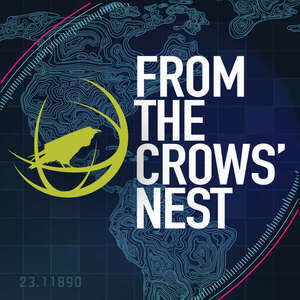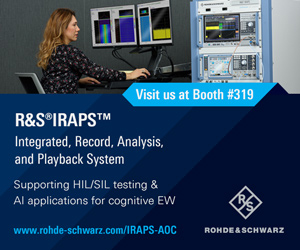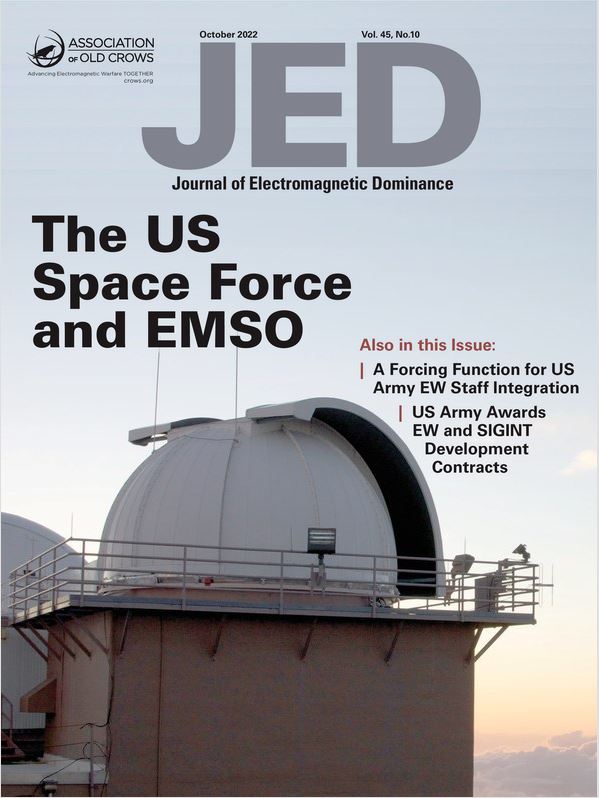.png) |
||||||||||||||||||||||||||||||||
| Archive | Subscribe | Crows.org | JED Resource Guide | WWW.JEDONLINE.COM | ||||||||||||||||||||||||||||||||
|
From the Editor
Thursday's Theme: Looking Toward the Future It's the final day of AOC 2022, and what a week we've had so far – outstanding speakers and presentations and lots of energy in the exhibit hall. Our theme, today, is "Looking Toward the Future." Our future doesn't simply happen on its own. We create EMSO's future by developing a vision, building strategies and shaping culture. Some questions to ponder are: • Enabling Technologies: What are some of the enabling technologies from outside the EMSO ecosystem that you want to become available in the next 5-10 years? How can you connect to those development communities to send a demand signal? • Stovepipes: Many aspects of today's EMS enterprise were established decades ago. What are the major stovepipes across EMSO organizations, processes, training, professional development, etc. that we need to break down to deliver better and faster solutions for the warfighter? Where would you begin tearing down stovepipes in your organization today to reshape it for tomorrow? • Industrial Base: The DOD is reshaping the EW and SIGINT industry through new acquisition pathways and related acquisition initiatives, such as defining software and hardware standards. How will these developments continue to influence the structure of the EW and SIGINT industry going forward? Visit the Convention website or download the app to learn more. In the latest episode of From the Crows’ Nest, host Ken Miller sits down at AOC 2022 with David Tremper, Director of Electronic Warfare in the Office of the Undersecretary of Defense for Acquisition and Sustainment. David is the US Department of Defense’s senior leader providing guidance and advocacy for US development and acquisition of EW capabilities and systems. Ken and Dave discuss a range of topics related to the concept of an EMSO Playbook, including Electromagnetic Protection, Open Architecture and Government Reference Framework and Counter C5ISR&T capabilities focusing on offensive EW. To learn more about today’s topics or to stay updated on EMSO and EW developments, visit our homepage.
Today's Events
SCHEDULE OF EVENTS - Thursday, Oct. 27
Symposium Happenings
The Wednesday morning keynote address was delivered by Chris O'Donnell, Deputy Assistant Secretary of Defense, Platform and Weapon Portfolio Management, OUSD A&S, who provided an excellent overview of the way the DOD has gone about implementing acquisition reform across the Department. O'Donnell began with a brief description of the strategic environment. "After years of focusing on operations conducted against violent extremist organizations," he said, "we now face a more complex security environment. With the people of Ukraine foremost in our minds, Russia poses an acute threat that is demonstrated by its unprovoked and brutal invasion. But at the same time, the People's Republic of China is our most consequential strategic competitor and DOD's pacing challenge." "Our adversaries are not waiting for us," he continued. "Across all domains, they are constantly seeking to out compete and out innovate us. Considering our strategic competitors have advanced layered and integrated sensing and electromagnetic warfare capabilities, now more than ever, the US needs to maintain superiority across the spectrum." In response to these threats, O'Donnell said, "I'm asking for your help in this effort. Acquisition is a team sport. And whether government, industry or international partner, everyone in this room plays an irreplaceable role. Companies across our defense industrial base have shown that they can quickly respond to any threat or challenge. I'm seeing this every day, as we deliver hundreds of thousands of weapons and equipment to Ukraine, using our presidential drawdown authorities and other Ukraine security assistance funds." He urged the audience, "We have to work together to make sure we're enabling speed through the right incentives and learning innovative authorities to assess, as well as integrate, emerging technologies. Just look at continued Starlink operations in the Ukraine. They're directly demonstrating the significance of assured communications and access to reliable information for both the military and public during warfare. The EMS survivability attributes implemented by Starlink have highlighted the value of robust electronic protection features, open system design and the systems' ability to rapidly be upgraded and fielded through software." O'Donnell said the National Defense Strategy advances the US's security goals in three primary ways: integrated deterrence, campaigning and building enduring advantages. "Building enduring advantages to enable integrated deterrence requires the right mix of capabilities and technologies woven together to defend against current and future threats," he explained. "To deliver that mix, our approach to acquisition must be flexible enough to adapt to today's evolving strategic landscape. And we must prioritize resources and efforts that achieve the strategic objectives set forth in the NDS, as well as in the Department's 2020 EMS Superiority Strategy." "To expedite the fielding of the latest technology and achieve EMSO superiority, we must continue to evolve our policies, processes, and most importantly our culture," he said. "In many ways, we began this process in recent years with a comprehensive update of the Defense Acquisition System, and creation of the Adaptive Acquisition Framework." O'Donnell went on to describe how the Framework creates multiple new acquisition pathways. The Middle Tier Acquisition (MTA) pathway, which is focused on speed, has been extremely useful for many EMSO development programs. "So, what has worked and what hasn't?" he asked. "What capabilities have we fielded at scale using the rapid pathways. We can move faster and get better results by taking calculated risks. But assuming all programs need to be acquired rapidly ignores lessons learned the hard way. And if we end up leaving too many capability areas with only demonstrations or potential solutions, we are actually not fielding faster. As we continue to drive the cultural shift to embrace the flexibility afforded by the Adaptive Acquisition Framework, we also recognize that the framework alone is not enough. Later in his address, he said, "By better integrating the three distinctive independent processes – Requirements, Resourcing and Acquisition Management, we can more effectively transition emerging technology across the proverbial valley of death. And to truly identify and address interdependencies and critical risks, we must also broaden our assessments to include not just systems, but portfolios of systems." He explained that the DOD had created integrated acquisition portfolio reviews, or IPRs, "to strengthen the synchronization of warfighting concepts, requirements, technologies and program execution." "At their core," he said, "IPRs and the mission engineering mindset foster collaboration across DOD to deliver integrated suites of capabilities that are collectively stronger than the sum of the parts. And about six months ago, we completed our Counter-C5ISRT IPR. We were able to show the Department what EW can do in order to address one of the most critical problems we currently face in a peer to peer competition. Mr. David Tremper…leads that effort, and it was really great to see how across the Department we can look at different EW capabilities and bring them to bear very quickly – once we identified that fact that there may be a Navy program that the Army can leverage or an Army program that the Air Force can leverage and move across quickly." He said these experiences had led the Department to create Competitive Advantage Pathfinders (CAPs) "to demonstrate challenges and solutions across our decision support systems." Addressing EMSO more specifically, O'Donnell said, "EMS superiority is dependent on our ability to maneuver within the spectrum, which requires investments in electromagnetic battle management to increase situational awareness; interoperability improvements and message and data standardization across the joint force, as well as between US and our coalition and allied partners; advanced electromagnetic protection of EMS-dependent systems to ensure we can operate in a contested and congested environment; and adaptable and resilient infrastructures particularly in space based capabilities. This includes targeted investments and innovative and novel capabilities, such as cognitive EW to counter advanced and non-traditional threats to break an adversary's kill web, with an emphasis on C5-ISRT, or left of launch capabilities." He added, "A number of enabling technologies will allow us to keep pace with evolving threat to operate in a complex electromagnetic environment. These include open architecture standards and government reference frameworks; assured PNT and JADC2; and EMSO planning tools, decision aids and visualizations. Historically one of the biggest challenges in advocating for EMSO funding has been articulating the importance of these capabilities to overall mission success. This is especially true if a particular budget trade off will result in buying fewer weapon systems to deliver the desired kinetic effect. As such, we must make a compelling argument for the value of EMSO capability in the context of the mission. Portfolio Management and mission engineering allow us to do just that." "Ultimately," he said, " the EMS is the connective tissue for all domains, and a linchpin for maintaining our competitive advantage in almost all missionaries. All it takes is turning on the news to remind us this isn't good enough. So, in the context of against a complex adversary like China, we need to ask more of ourselves. What can we do to provide them some capability more effectively and efficiently?" At Wednesday’s breakout session on cognitive EW, panelists Michael Schmid, expert in costly risk prevention, AI, MIT; David Zurn, division head of the test engineering division, GTRI’s Electronic Systems Laboratory (ELSYS); Dr. Karen Haigh, expert in cognitive EW, AI and ML for physical systems; and Dylan E Duplechain, GS-15, chief engineer, 350th Spectrum Warfare Wing, Eglin AFB, answered questions from moderator Dr. William “Dollar” Young, Jr., PhD, retired Colonel and former Commander, 350th Spectrum Warfare Wing, in front of a standing-room-only crowd. The questions focused mainly on how cognitive EW can be improved. Below are some highlights of the panelists’ answers: Dollar: How soon do you think we’ll see widespread adoption of cognitive EW, and what do you think is the most important barrier that must be addressed immediately by government, industry and academia? Dr. Karen Haigh: The biggest barrier is the thinking, the fear, the risk that we’re doing the wrong thing. You can see that propagating from policy all the way down to individuals who are developing the technology. We have to just be willing to take the risk. It might not do the right thing, but even if it’s infinitesimally better than the previous version, it’s infinitely better than the previous version. Epsilon is greater than zero means it’s infinitely better than zero and we need to be willing to take risks, to take those steps because China is seriously outpacing us and we’re behind. Dollar: Bloomberg published an article by Max Chafkin earlier this month with the headline “Even After $100 Billion, Self-Driving Cars are Going Nowhere” that challenged the assumption that widespread adoption of autonomous vehicles is right around the corner. If we assume that warfighting is more complex than driving a car, how do we avoid cognitive EW following the example and having the problems that autonomous vehicles are seeing? David Zurn: I don’t like the headline. Self-driving cars are not going nowhere. Elon Musk tends to make pretty bold predictions, that’s what he does, but the fact is there has been incremental progress in self-driving cars. You see even in standard cars a lot of automated features like lane-change systems that are leading up to self-driving. … Just because we’re not at the top doesn’t mean we’re not making any progress. Dollar: How do we establish trust among not just operators, but among the senior leaders and decision makers and stakeholders, and then how are we going to measure risk? Dr. Karen Haigh: A lot of cases I think it’s the baby step thinking — getting people used to the ideas as we go along. You think about your autonomous vehicles, once upon a time cruise control people would never trust, now we trust cruise control and we get (upset) if it doesn’t have the automatic radar to slow you down from the vehicle in front.
Wednesday afternoon saw the annual AOC Assembly of Delegates, a gathering of members and chapter representatives from around the globe. AOC President Glenn Carlson, who was finishing his term, began the meeting and reported the state of the association and provided a review of the AOC's major activities over the previous year. He said the AOC membership remains steady at over 14,000 EW and EMSO professionals, and the association is financially solid. He said the AOC is one year into its five-year strategic plan. The main five goals are: • Grow our global membership – both individual and corporate to commensurate with our market. • Build an advocacy and communications enterprise to deliver timely and professional resources and support to stakeholders. • Diversify our streams of revenue to strengthen our ability to adapt to an ever-changing business environment. • Strengthen international programs to reflect our global presence by increasing international membership; enhancing membership experience; and developing a plan to improve member engagement. • Grow professional development certification and STEM programs to cultivate the next generation of leaders in Electromagnetic Warfare and EMSO. Toward the end of the meeting, Carlson called the incoming AOC President, Brian Hinkley, and administered the oath of office. Hinkley, in turn, introduced the 2023 AOC board members. Exhibitor Happenings
Official Exhibit Hall hours during the AOC Convention are as follows: Today Learn more about exhibitor happenings and special events on the AOC Convention's Exhibit Hall Hours & Happenings page.
Inside the Convention
Keynote Session: Today's keynote will be delivered by Dr. Eric Haseltine, Author, Futurist, former NSA; and will also feature Mr. Lance Spencer, Client Executive Vice President - AT&T Global Public Sector, AT&T. Closing Symposium Spotlight Session: As a senior leader panel, this group is directly involved in diverse efforts to integrate requirements, capabilities, and budgetary items. The panel will discuss not just the EW EXCOM, but the other important governance bodies across the EMS Enterprise such as the C3LB and the PNT Council. The panel will discuss how EMSO capabilities are integrated into larger mission capabilities in the DoD and ultimately lead to individual programs for industry. Lastly, the panel will touch on the relationships to the Interagency governance structures for advanced EMSO capabilities. Symposium Breakout Sessions: 5G/Next G — This panel will discuss how 5G supports EMSO. Beginning with the architecture, the panel will discuss how 5G building blocks can be leveraged to enable future EMS operations. 5G represents another spin-in technology from commercial to defense applications. Over time, how these spin-in technologies transform our expectations of distributed processing, testing of complex systems, and networked system-of-systems. Joint Coalition EMSO Integration — EMSO must be a fully integrated and trained feature of the Joint Force that aligns with allied partners. Technical advances with commensurate training and readiness standards must be strategically, operationally, and tactically aligned to the ability for military services to meet joint requirements in cooperation with our allied partners. This includes systems operating in the RF, but also EO/IR, and DE portions of the EMS. Program Manager Briefing Series: Directed Energy More details are available from our symposium agenda. JED News
Cover Story: The US Space Force and EMSO News: US Army Awards EW and SIGNIT Development Contracts Start reading the issue now, and read more each week at jedonline.com The Journal of Electromagnetic Dominance (JED) is the official publication of the Association of Old Crows (AOC), an independent, nonprofit, international professional association promoting public understanding in the science and practice of EW, SIGINT and related disciplines. Become an AOC member to get access to the latest issue of JED. Chris Johnston is Director of Keysight’s Radar & Electronic Warfare Solutions, where he leads a highly experienced team of solution planners and business development managers. Chris began his career at Keysight (then Agilent Technologies) in 2000 working as a field engineer on strategic defense and component accounts. He moved into his current role in March 2021. Chris has a BS in Electrical Engineering from the University of Cincinnati, and he is an AOC member belonging to the Mile High Country Crows Chapter. JED: What are some of the major EMS Operations (EMSO) trends that you are seeing and how are they driving the types of test equipment that Keysight is offering for the EW market? Johnston: From a test perspective, we see EMS operational requirements mapped directly to test and evaluation and those requirements go well beyond the capabilities of a single spectrum analyzer, arbitrary waveform generator, or oscilloscope. Diminishing are the days of testing with a “box” used for one single type of test. It is a much more solution-oriented approach, which requires the integration and combination of many legacy and emerging test ideologies that drives our business today. Our government and industry customers require us to help to integrate complex test solutions that incorporate next-generation technology, while including importer tools and compatibility with legacy solutions, to not lose years of engineering work. This is an important requirement. Otherwise, we are placing the burden of integration on them, which slows down their core business – creating the protection and countermeasures systems and algorithms necessary to protect the warfighter. It is the leverage of multiple traditional test assets, or their associated IP, collated to create a more comprehensive solution, which is now the norm. This includes the drive to develop multi-domain (frequency and time) measurement tools to address more complex test needs to test mixed RF and digital devices. Parallel to improving the hardware, there is high demand on the software modeling and simulation environment required to control – and replicate – both the simple and complex scenarios of an entire A2AD environment. Recognizing as the A2AD becomes more complex, we must challenge our R&D teams to provide more SWaP-C optimized test solutions, as well. To read the rest of this interview at JEDonline, click here.
Digital Pub Bin
Check out current issues from our media partners. You'll also be able to find news coverage from throughout the week on the AOC Convention's News page. JED
|
||||||||||||||||||||||||||||||||








 The October issue of JED includes these highlights:
The October issue of JED includes these highlights: